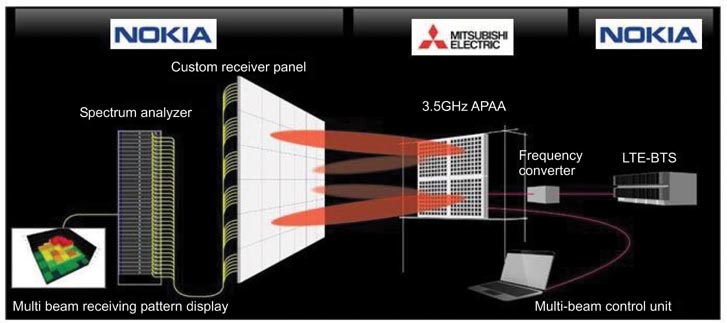Mitsubishi Electric Corporation announced that it has developed a prototype Active Phased Array Antenna (APAA) to verify new multi-beamforming technology for envisioned fifth-generation (5G) mobile networks. Mitsubishi Electric have exhibited the prototype in a 5G multi-beamforming demonstration that it was conducted jointly with Nokia Networks at the Brooklyn 5G Summit in New York City starting April 8.
Key features of the APAA prototype are as follows:
- Four-beam spatial multiplexing achieved with a multi-element antenna.
- Beamforming control of the direction of radio signal transmission and reception for two-dimensional vertical and horizontal scanning.
- Use of 3.5 GHz, the highest frequency available in current cellular mobile communication.
In the demonstration of beam-steering control using four beams, Mitsubishi Electric will connect its APAA prototype to Nokia Networks' base station equipment to confirm the four beams' characteristics simultaneously. Mitsubishi Electric and Nokia Networks will continue to jointly evaluate APAA technology for 5G mobile networks.
 |
| Scheme of joint demonstration. |
Multi-beamforming is expected to achieve efficient frequency utilization by forming and multiplexing a plurality of beams using multi-element antenna arrays. Mobile systems based on 5G, the mobile standard that will succeed LTE and LTE-Advanced, will use multi-beamforming to cope with fast-increasing radio traffic volume.
Mitsubishi Electric's APAA technology is already used commercially in satellites and other systems, and now the company aims to adapt it for use in 5G base stations.
The Brooklyn 5G Summit, which have been jointly held by Nokia Networks and the NYU WIRELESS research center at the Polytechnic School of Engineering at New York University, was focused on important trends in 5G wireless technologies.
